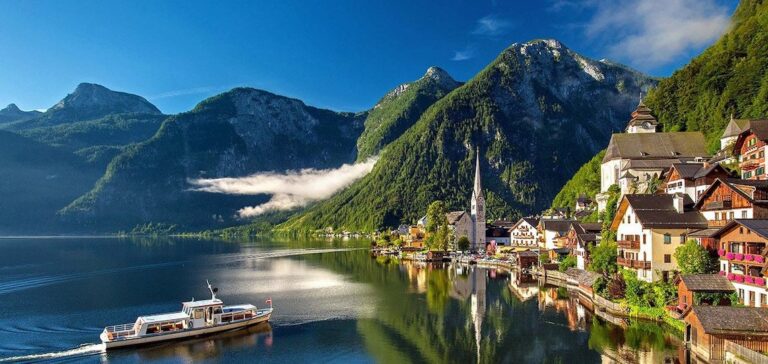At an altitude of 2,040 meters, 350 workers are busy on a spectacular construction site, the symbol of a hydro-dependent Austria that must adapt to global warming. They are building a new power station in the mountains, capable of storing energy above the Salzburg village of Kaprun, at a wild and inhospitable altitude, even in summer.
Drought control and glacier melt turn Austria’s hydraulics upside down
Their veritable cathedral, packed with technology, is buried beneath a backdrop of white peaks and dizzying dams, flown over by eagles and trodden by ibex. At the foot of the statue of Sainte-Barbe, patron saint of dangerous jobs, we have just celebrated the end of heavy excavation work in oppressive tunnels, pulsating with the comings and goings of trucks.
The aim is to expand existing facilities by 2025 to absorb peaks in electricity consumption and respond to increasingly erratic rainfall. Rising temperatures also cause drought and accelerate the melting of snow and ice, threatening river supplies.
“We’ll have less water in summer and more in winter,” says Klaus Hebenstreit, an executive with the semi-state-owned Verbund, the country’s main electricity producer. “We want to be as prepared as possible” for these new challenges, he stresses.
Hence this gigantic storage power plant project, capable of producing on demand thanks to energy reserves.
At the other end of the country, the Freudenau site on the Vienna Danube supplies over 240,000 households. It operates on the run of the river, according to its flow. Its six turbines, each 7.5 meters in diameter, are impressive, and as the school year draws to a close, school trips come to admire them.
Austrian hydropower: A dual face of pride and climate challenges
These are all installations that emit no CO2 during use and are the pride of Austria, even if their impact on ecosystems is not negligible and is regularly denounced by environmentalists. With more than 3,100 dams harnessing almost all of its waterways, the country derives over 60% of its electricity production from this renewable energy source, compared with a global average of 16%.
But global warming is already making itself felt, and the figures are falling: hydropower generated 42 terawatt-hours (TWh) in 2021, down from 45 TWh in 2020, according to Statista. For the first time last year, this prosperous country – which is also struggling to give up Russian gas supplies – had to resort to… import electricity, a real wake-up call. This is the result of “several years of drought”, explains Roman Neunteufel, a researcher at the Agricultural University of Vienna. “Water levels had never been this low since records began” a hundred years ago.
Impact of global warming in Europe and heat records
Europe experienced a year 2022 2.3 degrees warmer than the climate at the end of the 19th century, according to the latest annual assessment by the United Nations World Meteorological Organization (WMO) and the European Copernicus network. And Alpine glaciers experienced “record mass loss”.
“If it’s not possible to produce much because of low flow rates, it’s clear that other resources will have to be used,” warns the expert. Against this backdrop, Verbund is investing billions of euros in the expansion of its fleet, to improve security of supply and develop alternatives. “We’re diversifying,” explains Klaus Hebenstreit, interviewed in the Austrian capital in the sweltering 37-degree heat. “While water will remain the core of our business, we now also have photovoltaics and wind power”.
For a country hostile to nuclear power, which had bet everything on a seemingly inexhaustible resource and is aiming for 100% renewable electricity by 2030, their development is a headache.
“Solar energy is great in summer,” says Roman Neunteufel. “But production is too low in winter, precisely when we need it for heating”. “And with wind it’s even worse: when there isn’t any, production is simply interrupted”, according to the researcher.
Accustomed to the epinal image of crystal-clear water flowing in abundance through green meadows, Austria has been slow to turn to wind and solar power, which account for just 13% of its energy package.






















